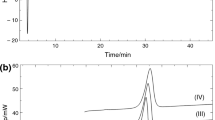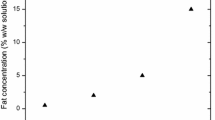Abstract
We have studied the pre-nucleation behavior of tripalmitin (TP) and tristearin (TS) in blends with triolein (TO), high oleic safflower oil (HOSfO) and soybean oil (SBO) by means of fluorescence polarization spectroscopy (FPS) and molecular mechanics simulations (MM). The FPS measurements at different temperatures showed that there is an increase in the anisotropy of the TP:HOSfO and TP:SBO blends as opposed to the TP:TO sample. This increase is directly related to an increase in the microviscosity of the blend which is interpreted as a structuring step prior to the nucleation and growth of the crystals. A similar but less pronounced effect was also observed in the TS:SBO blends. We performed MM simulations in an attempt to understand the molecular interactions responsible for this behavior. The simulation results have shown that short range van der Waals (vdW) interactions are the ones responsible for the increase in the microviscosity of the blends prior to crystallization. Our results also indicate that the presence of molecules that contain at least one chain of palmitic acid in their triglyceride (TAG) composition will induce a pre-nucleation increase in the microviscosity of the blend in both TP and TS containing systems. Lastly, we studied the applicability of these conclusions to longer chain TAG analogues. Our MM results show that hypothetical blends of TS and TAGs containing stearic acid in their structure, will not have a low enough vdW energy to account for an increase in the microviscosity. Hence, there seems to be a specific interaction particularly favorable when the oil contains TAGs with at least one palmitic acid chain.




Similar content being viewed by others
References
Freedericksz V, Zolina V (1933) Forces causing the orientation of an anisotropic liquid. Trans Faraday Soc 29:919–930
Cebula DJ, McClements DJ, Povey MJW, Smith PR (1992) Neutron diffraction studies of liquid and crystalline trilaurin. J Am Oil Chem Soc 69:130–136
Larsson K (1972) Molecular arrangement in glycerides. Fette Seifen Anstrichmittel 74:136
Minato A, Ueno S, Smith K, Amemiya Y, Sato K (1997) Thermodynamic and kinetic study on phase behavior of binary mixtures of POP and PPO forming molecular compound systems. J Phys Chem B 101:3498–3505
Ueno S, Minato A, Yano J, Sato K (1999) Synchrotron radiation x-ray diffraction study of polymorphic crystallization of SOS from liquid phase. J Cryst Growth 198:1326–1329
Corkery RW, Rousseau D, Smith P, Pink DA, Hanna CB (2007) A case for discotic liquid crystals in molten triglycerides. Langmuir 23:7241–7246
Larsson K (1992) On the structure of the liquid state of triglycerides. J Am Oil Chem Soc 69:835–836
Hernqvist L (1984) On the structure of triglycerides in the liquid state and fat crystallization. Fette Seifen Anstrichmittel 86:297–300
Larsson K (1979) An x-ray scattering study of the L2-phase in monoglyceride-water system. J Colloid Interface Sci 72:152–153
Toro-Vazquez JF, Gallegos-Infante A (1996) Viscosity and its relationship to crystallization in a binary system of saturated triacylglycerides and sesame seed oil. J Am Oil Chem Soc 73:1237–1246
Marangoni AG (2002) Steady state fluorescence polarization spectroscopy as a tool to determine microviscosity and structural order in lipid systems. In: Marangoni AG, Narine S (eds) Physical properties of lipids. Marcel Dekker, New York, pp 163–189
Murakami A, Nakaura M, Nakatsuji Y, Nagahara S, Tran-Cong Q, Makino K (1991) Fluorescent-labeled oligonucleotide probes: detection of hybrid formation in solution by fluorescence polarization spectroscopy. Nucleic Acids Res 19:4097
Parasassi T, De Stasio G, d’Ubaldo A, Gratton E (1990) Phase fluctuation in phospholipid membranes revealed by Laurdan fluorescence. Biophys J 57:1179–1186
Yguerabide J, Stryer L (1971) Fluorescence spectroscopy of an oriented model membrane. PNAS 68:1217–1221
Royer CA (1995) Fluorescence spectroscopy. Methods Mol Biol 40:65–89
Mann TL, Krull UJ (2003) Fluorescence polarization spectroscopy in protein analysis. Analyst 128:313–317
Nagarajan K, Myerson AS (2001) Molecular dynamics of nucleation and crystallization of polymers. Cryst Growth Des 1:131–142
Terrill NJ, Fairclough PA, Towns-Andrews E, Komanschek BU, Young RJ, Ryan AJ (1998) Density fluctuations: the nucleation event in isotactic polypropylene crystallization. Polymer 39:2381–2385
Perez-Martinez D, Alvarez-Salas C, Charo-Alonso M, Dibildox-Alvarado E, Toro-Vazquez JF (2007) The cooling rate effect on the microstructure and rheological properties of blends of cocoa butter with vegetable oils. Food Res Int 40:47–62
Kloek W, Walstra P, van Vliet T (2000) Crystallization kinetics of fully hydrogenated palm oil in sunflower oil mixtures. J Am Oil Chem Soc 77:389–398
Lakowicz JR (1999) Fluorescence anisotropy. In: Lakowicz JR (ed) Principles of fluorescence spectroscopy. Plenum Press, New York, pp 291–319
Allinger NL (1977) Conformational analysis. 130. MM2. A hydrocarbon force field utilizing V1 and V2 torsional terms. JACS 99:8127–8134
Weber G, Shinitzky M, Dianoux AC, Gitler C (1971) Microviscosity and order in the hydrocarbon region of micelles and membranes determined with fluorescent probes. I. Synthetic micelles. Biochemistry (NY) 10:2106–2113
Mateo CR, Lillo MP, Brochon JC, Martinez-Ripoll M, Sanz-Aparicio J, Acuna AU (1993) Rotational dynamics of 1,6-diphenyl-1,3,5-hexatriene and derivatives from fluorescence depolarization. J Phys Chem A 97:3486–3491
Vereecken J, Foubert I, Smith KW, Dewettinck K (2009) Effect of SatSatSat and SatOSat on crystallization of model fat blends. Eur J Lipid Sci Technol 111:243–258
Author information
Authors and Affiliations
Corresponding author
About this article
Cite this article
Dibildox-Alvarado, E., Laredo, T., Toro-Vazquez, J.F. et al. Pre-Nucleation Structuring of TAG Melts Revealed by Fluorescence Polarization Spectroscopy and Molecular Mechanics Simulations. J Am Oil Chem Soc 87, 1115–1125 (2010). https://doi.org/10.1007/s11746-010-1596-8
Received:
Revised:
Accepted:
Published:
Issue Date:
DOI: https://doi.org/10.1007/s11746-010-1596-8




